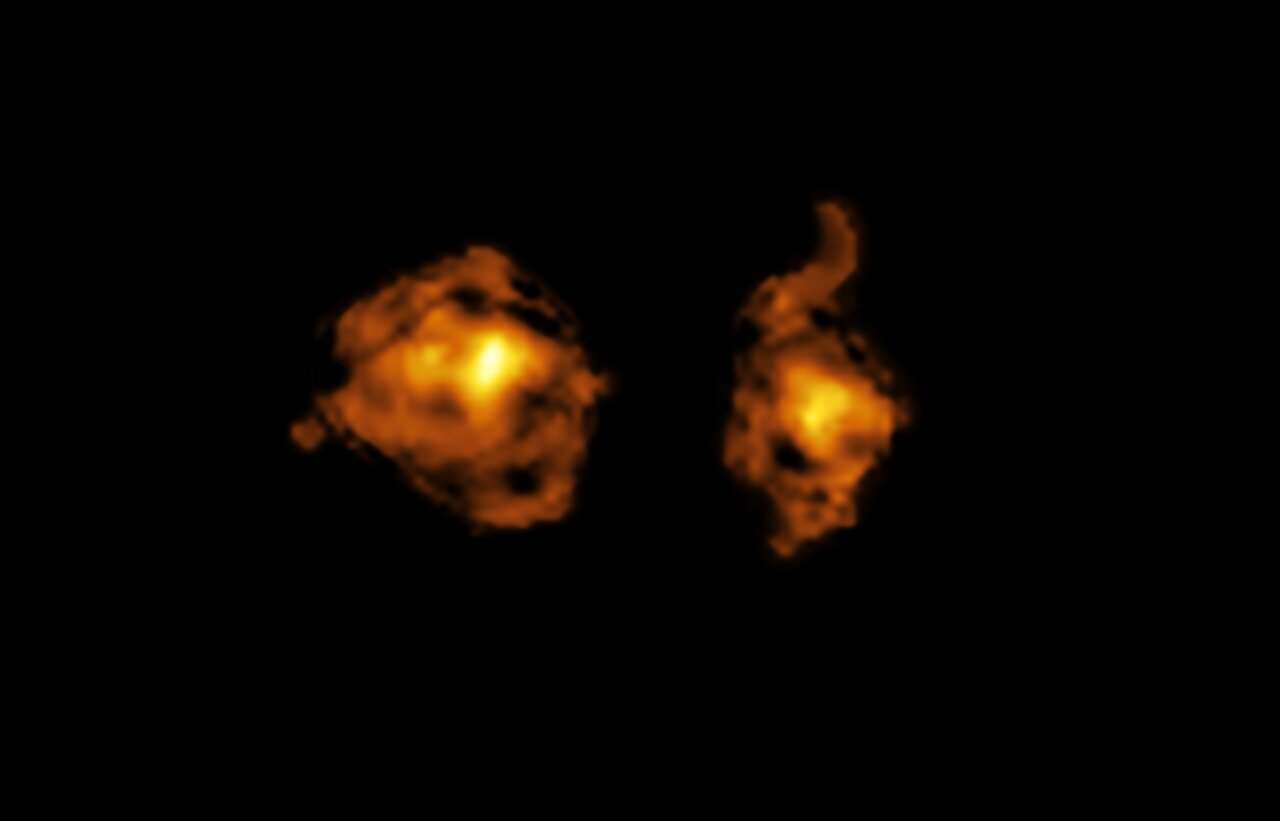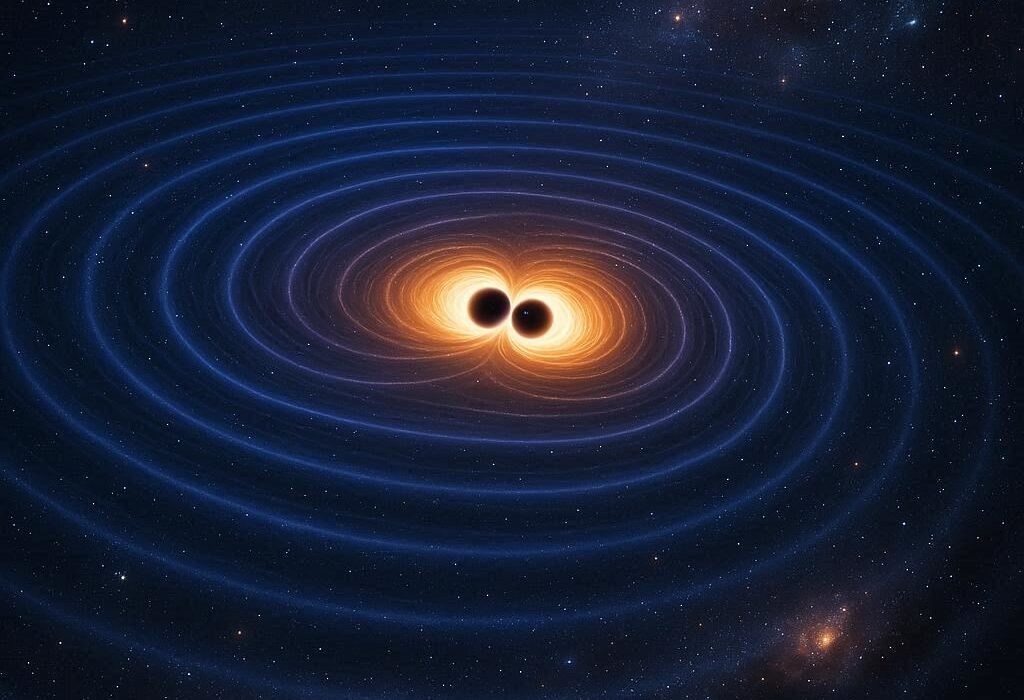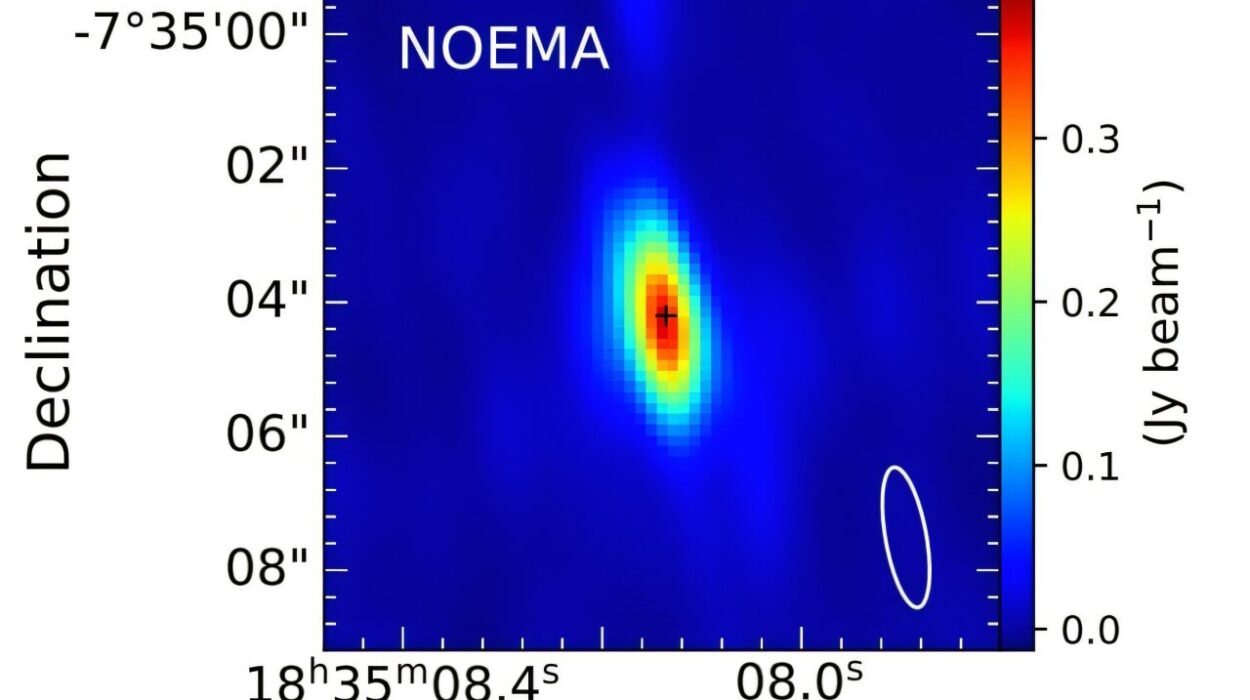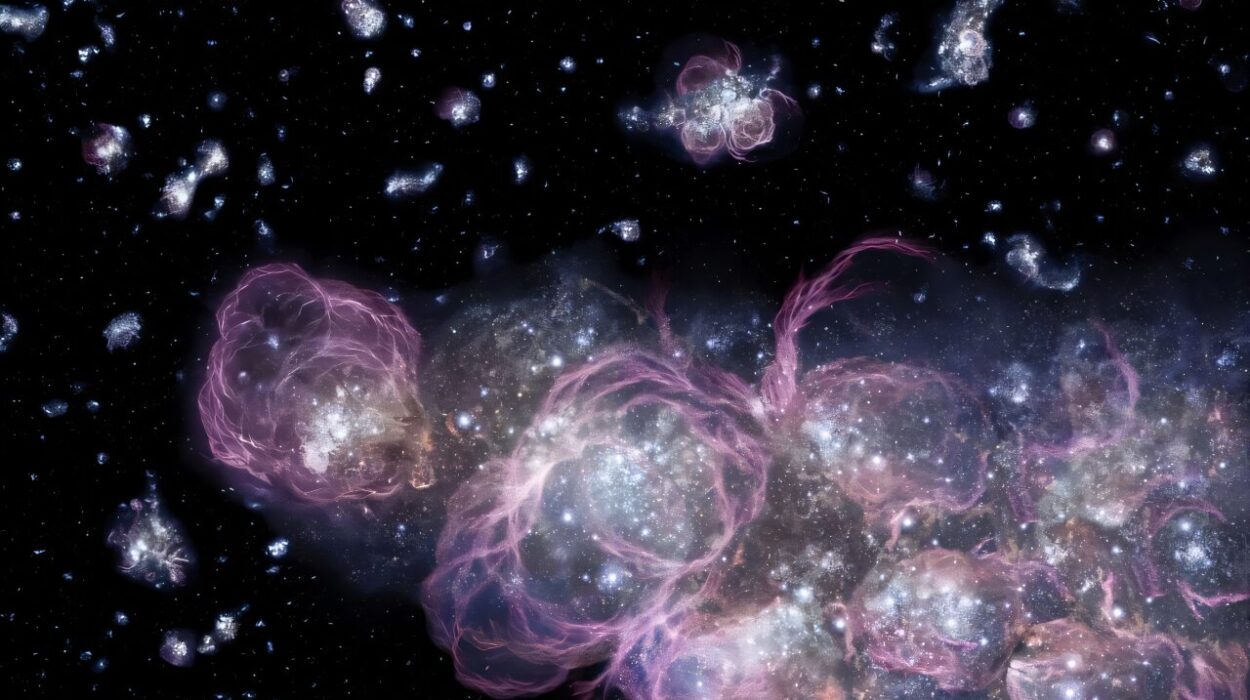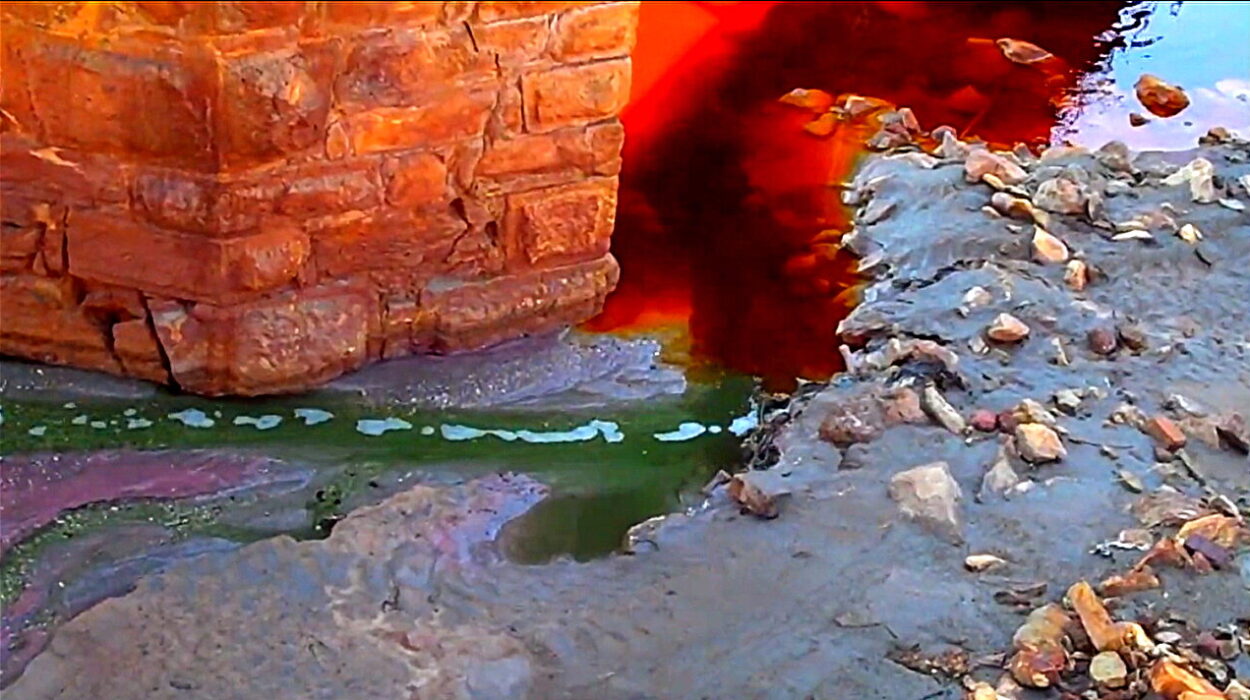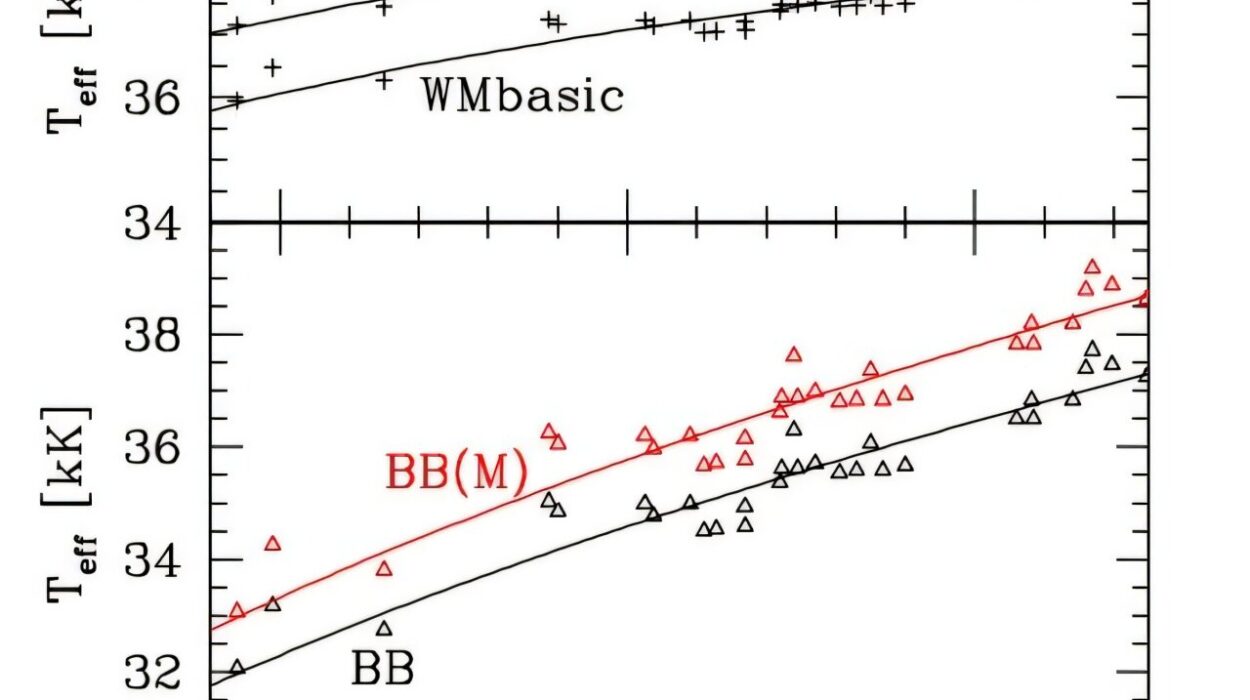In the vast, ancient darkness of the cosmos, two galaxies have locked themselves into a dramatic and violent celestial dance. Their battleground is a patch of sky so distant that the light from their combat has taken over 11 billion years to reach Earth—light born when the universe was a mere toddler, just 2.4 billion years old. Now, with the help of cutting-edge telescopes perched high in Chile’s Atacama Desert, astronomers have captured a never-before-seen spectacle: a galactic collision in which one galaxy uses a quasar—an intensely radiant core powered by a supermassive black hole—as a weapon to literally spear its rival.
This extraordinary discovery, published in Nature, doesn’t just dazzle with its violence and beauty—it reshapes our understanding of how galaxies evolve and how cosmic radiation can suppress the birth of stars. For the first time, astronomers have observed how quasar radiation directly disrupts the inner gas of another galaxy during a merger, essentially halting that galaxy’s ability to create new stars. It’s not just a cosmic joust—it’s a transformation.
A Duel in Deep Time
To peer into the early universe is to look back in time, and the universe of 11 billion years ago was a turbulent place. Galaxies collided frequently, and quasars burned with ferocity as black holes gorged themselves on torrents of cosmic gas. While we’ve known for years that galaxy mergers can trigger quasar activity and that quasars can affect their surroundings, this is the first time scientists have watched one galaxy slam into another while being skewered by a quasar’s radiation in real time—or rather, in cosmic light-time.
What makes this duel so striking is its choreography. The galaxies are not simply crashing together in a straight line. Instead, they repeatedly swoop in, strike, and recoil—like knights locked in a medieval joust, complete with shining spears and thunderous impacts. “We hence call this system the cosmic joust,” says Pasquier Noterdaeme, co-lead author and researcher at the Institut d’Astrophysique de Paris and the French-Chilean Laboratory for Astronomy. But unlike its chivalric namesake, there’s no honor or fairness in this battle.
One galaxy holds the upper hand: it is armed with a quasar.
Quasars: Cosmic Lighthouses with the Power to Destroy
A quasar is one of the most energetic objects in the universe. Hidden within the galaxy’s heart lies a supermassive black hole that’s actively devouring gas and dust. As material spirals into the black hole’s maw, it heats up and emits enormous amounts of radiation—often outshining the rest of the galaxy. It’s this searing light, rather than gravity or direct physical contact, that delivers the blow.
In the case of the cosmic joust, the quasar’s radiation pierces the nearby galaxy like a high-powered laser, tearing through the interstellar clouds that serve as stellar nurseries. “Here we see for the first time the effect of a quasar’s radiation directly on the internal structure of the gas in an otherwise regular galaxy,” says Sergei Balashev, co-lead author from the Ioffe Institute in St. Petersburg, Russia.
The effect is devastating. Normally, galaxies rely on cool, dense clouds of hydrogen gas to collapse under gravity and give birth to new stars. But the quasar’s radiation disrupts this process. It strips away or ionizes the diffuse gas, leaving behind only a few compact, resilient knots of matter—too small and too isolated to spark the formation of stars. In effect, the galaxy has been sterilized, its celestial womb cauterized by radiation.
Turning Telescopes Into Time Machines
To capture this cosmic skirmish, astronomers turned to two of the most powerful observatories on Earth: the Atacama Large Millimeter/submillimeter Array (ALMA) and the X-shooter instrument on the European Southern Observatory’s Very Large Telescope (ESO’s VLT). Both are perched on high-altitude plateaus in the Atacama Desert of Chile, where thin air and dry skies offer some of the clearest views of the universe.
ALMA’s array of 66 precision radio antennas allowed researchers to separate the two galaxies, which had previously appeared as a single, indistinct smudge in earlier surveys. It revealed not only the structure of the galaxies but also detailed information about their gas content and motion—showing just how closely the galaxies interact, and how gas flows between them.
Meanwhile, the X-shooter instrument performed spectroscopic analysis, splitting light into its component wavelengths to probe the chemical and physical state of the matter within the galaxies. Critically, it allowed researchers to examine the light from the quasar after it passed through the wounded galaxy. Like forensic scientists at a crime scene, astronomers used this backlit silhouette to assess the damage: the stripped gas, the altered chemistry, the disrupted environment. What emerged was a clear, if haunting, picture of a galaxy being deconstructed by radiation.
Galactic Cannibalism and Black Hole Fueling
But the drama doesn’t stop with the disfigurement of the star-forming galaxy. This cosmic joust also provides fresh fuel for the very black hole that powers the quasar. Galactic collisions are messy affairs, flinging gas in all directions and funneling matter into the gravitational wells at each galaxy’s center. In this case, the wounded galaxy—despite suffering loss—also contributes to the quasar’s power by delivering fresh supplies of gas to its tormentor.
“These mergers are thought to bring huge amounts of gas to supermassive black holes residing in galaxy centers,” says Balashev. As this gas is funneled inward, it ignites the black hole’s fury once more, powering continued radiation and enabling the cycle to repeat.
This feedback loop—a galaxy merger feeding a black hole, which powers a quasar, which in turn sterilizes part of its own environment—represents a complex, self-regulating system in galactic evolution. Quasars, it seems, aren’t just the product of galaxy mergers; they can also dictate the aftermath, quenching further star formation and even reshaping the fates of nearby galaxies.
The Larger Picture: A New Chapter in Cosmic Evolution
Until now, our understanding of galaxy evolution has relied heavily on simulations and indirect observations. We knew that quasars were bright and powerful. We knew they could blow out gas and create feedback effects. But this new observation is the first to clearly link a quasar’s radiation to direct and localized disruption in another galaxy’s star-forming regions. It’s a smoking gun.
This cosmic joust offers a missing piece of the puzzle. It gives astronomers a detailed look at what happens inside the galaxies during such a merger—not just the gravitational tug-of-war but the actual molecular consequences of these cataclysmic encounters. It also provides context for the evolution of the early universe, where galaxy collisions and quasar activity were far more common.
“This is a unique opportunity to study processes that were much more typical in the young universe,” says Noterdaeme. “The light from this event traveled for more than 11 billion years. We’re essentially watching a snapshot from the distant past—a rare window into an era when galaxies grew rapidly and black holes fed voraciously.”
Looking Ahead: New Eyes on the Universe
Though this study relied on ALMA and the VLT, astronomers are already looking ahead to future instruments. The upcoming Extremely Large Telescope (ELT), currently under construction in Chile, will dwarf all existing optical telescopes. With a 39-meter main mirror and advanced adaptive optics, it will allow researchers to peer even deeper into cosmic time, capturing finer details of these dramatic interactions.
“ELT will certainly allow us to push forward a deeper study of this and other systems,” Noterdaeme explains. “We’ll be able to observe many more galactic duels like this one, map the flows of gas, and better understand how quasars affect not just their host galaxies but the surrounding universe.”
As technology advances, so too does our ability to decode the universe’s most profound mysteries. Once limited to blurry smudges on photographic plates, we can now watch galaxies fight and fall, live and die, across billions of light-years.
Conclusion: A War of Light, a Story of Transformation
The cosmic joust captured by astronomers is not merely a spectacle of intergalactic violence—it’s a story of transformation. It shows us that galaxies are not isolated island universes, drifting passively through space. They are social, aggressive, ever-changing organisms that grow, merge, devour, and even destroy.
In this galactic duel, we see not just the brilliance of quasars and the wreckage they leave behind, but the broader narrative of how the universe builds structure. Star birth and star death, black hole feeding and gas stripping, growth and sterilization—all are part of the same cosmic script, written in the language of gravity and radiation.
And thanks to our ever-sharper tools and the relentless curiosity of scientists, we can now read that script with greater clarity than ever before. The universe, in all its violence and wonder, is telling us its story. All we have to do is look up—and listen.
Reference: Sergei Balashev, Quasar radiation transforms the gas in a merging companion galaxy, Nature (2025). DOI: 10.1038/s41586-025-08966-4. www.nature.com/articles/s41586-025-08966-4
